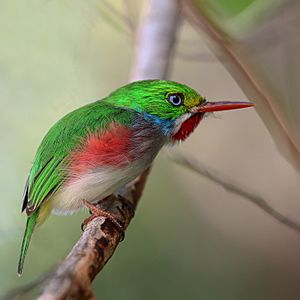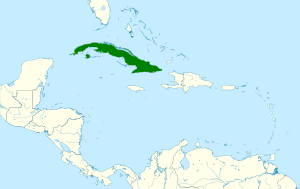Cuban tody facts for kids
Quick facts for kids Cuban tody |
|
|---|---|
 |
|
| on Cayo Guillermo | |
| Conservation status | |
| Scientific classification | |
| Genus: |
Todus
|
| Species: |
multicolor
|
 |
|
The Cuban tody (Todus multicolor) is a small, colorful bird. It belongs to the Todidae family. You can only find this bird in Cuba and the small islands nearby.
Contents
About the Cuban Tody
The Cuban tody is a very small bird. It is about 11 cm (4.3 in) long. This is about the length of a pen. It weighs only 5.9 g (0.21 oz), which is lighter than a few paper clips!
It has a large head compared to its body. Its bill is thin and flat. Like other tody birds, it has bright colors. Its back is a shiny green, which looks like it changes colors in the light. Its belly is a light grayish-white. It also has bright red spots.
What makes the Cuban tody special? It has pink sides and a red throat. It also has yellow spots near its eyes and a blue patch near its ears. Its bill has two colors: black on top and red on the bottom.
Where They Live
The Cuban tody lives in Cuba all year round. You can find them on the main island and the smaller islands close by. Scientists think there are two groups of these birds. One lives in eastern Cuba, and the other in western Cuba.
This bird can live in many different places. It likes dry lowlands and evergreen forests. You might also find it near the coast or close to rivers and streams. Cuban todies can be hard to spot. They often hide in thick bushes.
How They Behave
Cuban todies are often seen in pairs. When they sit on a branch, they sometimes make a quick "tot-tot-tot-tot" sound. Their most common call is a soft "pprreeee-pprreeee." This sound is why people in Cuba sometimes call them 'Pedorrera'.
When they fly, their wings make a whirring sound. They use this sound when they are showing off or trying to attract a mate.
Nesting and Babies
Cuban todies build their nests in tunnels. These tunnels are about 30 cm (12 in) long. They dig them into clay banks. At the end of the tunnel, there is a round room for the eggs. Sometimes, they use a hollow tree trunk or a hole in a tree instead.
They make the nest walls strong. They use a sticky substance mixed with grass, moss, feathers, and other bits. The female bird lays three or four eggs. Both the mother and father bird take turns sitting on the eggs to keep them warm.
What They Eat
The Cuban tody mainly eats insects. But they also enjoy small fruits, tiny lizards, and spiders. These birds sometimes join groups of different bird species to hunt for food together. This is called a mixed-species foraging flock.
Animals like the mongoose sometimes hunt Cuban todies for food.
See also
 In Spanish: Cartacuba para niños
In Spanish: Cartacuba para niños



